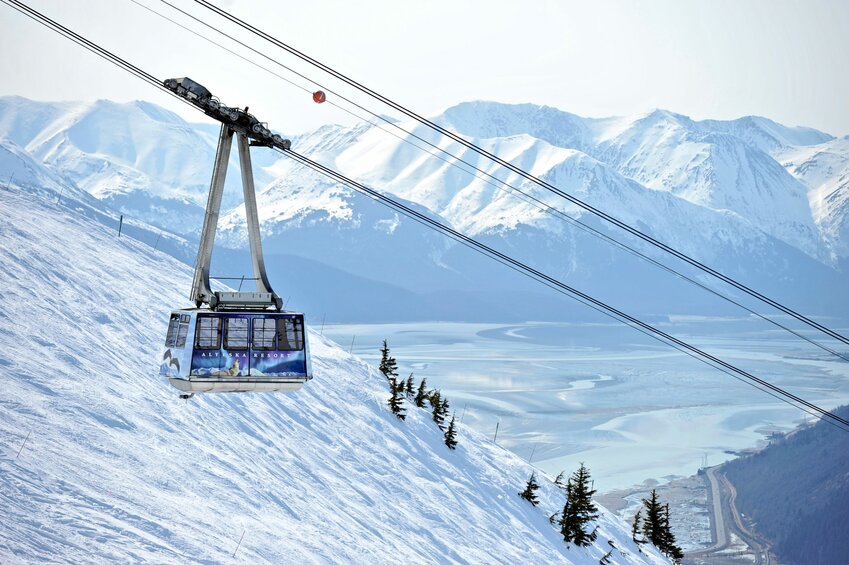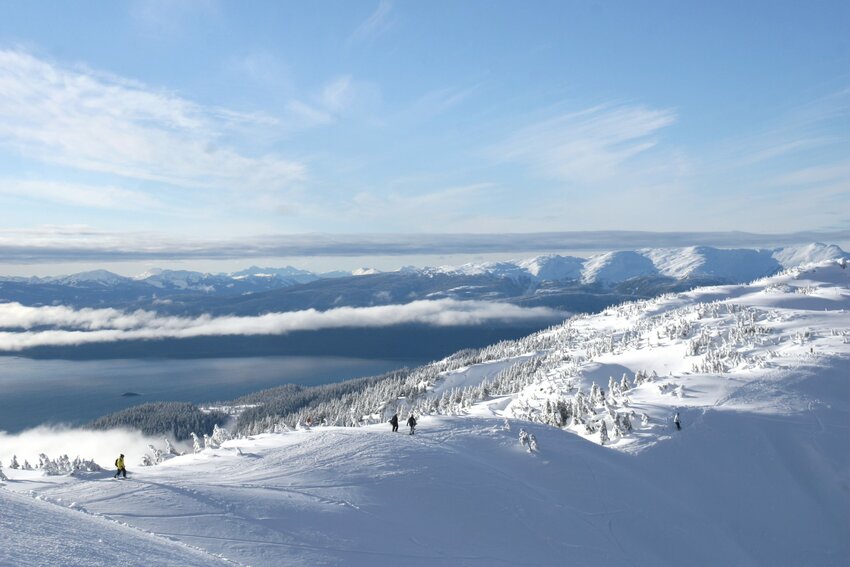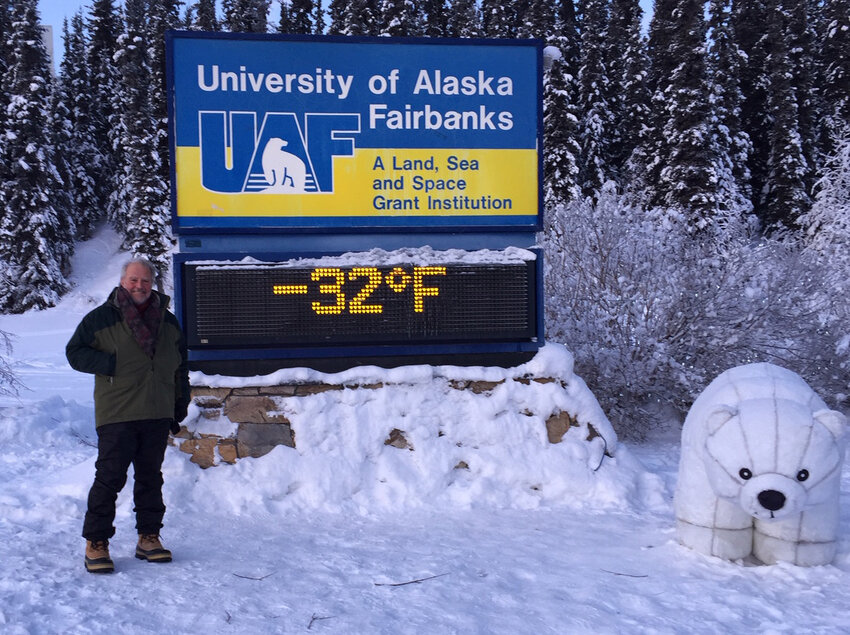 Photos courtesy Alyeska Resort
Photos courtesy Alyeska ResortIt’s a long way down from the top of Alyeska Ski Resort. In fact, when you reach the base, you swap out your skis for a board.
Surfboard, that is.
This is only a slight exaggeration — the lay of the land at Alaska’s largest ski mountain includes, well, land and sea. The lift base is at 250 feet above sea level, and Turnagain Arm is just a quarter-mile away. That’s the same Turnagain Arm world-famous for a bore tide that skilled surfers can ride for miles as it surges down the fjord toward Cook Inlet, coincidentally sluicing past Beluga whales.
I wouldn’t try that — it’s for sub-Arctic experts only — but I have certainly savored the scenery from the 2,750-foot top of the ski slope, from which sharp-eyed skiers can sometimes spy the bore tide. Calling this a big-mountain resort is linguistic understatement: It’s a very big mountain in a Brobdingnagian landscape in a state whose name is derived from the Aleut term that, yes, is the same as the ski resort. And what does that mean?
Great Land of the White.
 Photo courtesy Eaglecrest Ski Area/Travel Juneau
Photo courtesy Eaglecrest Ski Area/Travel JuneauNo dispute with that is possible. Alaska has a global rep for big, remote, exotic, wild, free, untrammeled, matchless adventure. Did I say big?
So why am I, a week later, chugging up a birch-clad ridge outside Fairbanks in a modest old yellow schoolbus along with a dozen other happy skiers? I’ve ski boots on my feet, Rossignols racked on the side of the bus. We are making use of what the ski area calls “variable capacity turbo-charged terrestrial trams.” The buses trudge uphill from bottom to top every 5-10 minutes, and the occupants cannot help scoffing at a journey that’s actually delightful.
“No kissing, now, or I’ll call teacher!”
“I’m in trouble tomorrow, the dog ate my homework.”
“Mom, I can’t go to school today, it’s too cold.”
This is Moose Mountain Ski Resort, a moniker that makes liberal use of the final word. No uphill lifts here; a modest base lodge; hardly any beginner territory. But when it is too cold (this is Interior Alaska) every bus ride warms you right back up. Can’t say that for some high-speed, six-pack chair in Montana, can you?
At Moose, the runs wend their way down through birch glades, and there are quite a few long, intermediate coasters dropping down the not-inconsiderable 1,300 feet of vertical drop. The crisp, below-zero snowpack is aurally and texturally unique.
Alyeska represents Alaska well: 1,760 acres, 650 inches of snowfall, 76 runs, 7 lifts, 2500 vertical feet, and the world’s longest double-black run. The latter beast — actually, an entire separate slope called the North Face — runs directly beneath the 60-passenger Alyeska tram, so skiers such as me heading for more reasonable terrain on the other side can gawk at the mega-experts picking their way down the 40-degree slope of sub-runs named Big Doo Doo or Wyatt’s Burp. The tram docks at a ridgetop lodge featuring what may be Alaska’s best restaurant, Seven Glaciers; and its base is next to a massive luxury hotel that is the only slope side lodging north of southern British Columbia.
But Moose Mountain is equally Alaskan, its quirky adaptations to Northland life mirroring many other aspects of the Great Land ethos. This is a state where large numbers of residents happily live in off-the-grid cabins with no indoor plumbing; these are called “dry cabins” and tenure in them is something to be proud of, not embarrassed by. Many Alaskans have been raised on moose and caribou meat and never tasted beef until they went to college. They toss Frisbees at 40 below in shorts and T-shirts, just to prove they can. No one graduates from the University of Alaska Fairbanks without a picture of them beside the U’s famous temperature sign, posing in swimsuits at 30 below or more.
 Eric Lucas on University of Alaska Fairbanks campus in 32 below temperatures. Courtesy Eric Lucas
Eric Lucas on University of Alaska Fairbanks campus in 32 below temperatures. Courtesy Eric LucasI’m not a UAF grad, so I keep my jacket on to document my visit at 32 below. Then off I go for Nordic skiing at Creamer’s Field, a marvelous park where you can ski over a sublimely picturesque footbridge in snowy woods, just like in a movie.
Alyeska and Moose are joined in downhill distinction by Ski Land, north of Fairbanks, which is the northernmost lift-served downhill area in North America. The view from the top here literally encompasses the Arctic Circle about 50 miles away. East of Fairbanks, military staff and family members at Fort Wainwright take to their own on-base slope, Birch Hill … How cool is that? And Eaglecrest, near Juneau, has sensational mountain and sea views to match Alyeska, and shares with it the saltwater air found at virtually no other ski resorts on Earth.
None of these places are crowded. Anchorage and Fairbanks are 4 hours by plane from Seattle, and farther still from anywhere else. You have to fly to Juneau — no road reaches Alaska’s capital. Theoretically, you can drive to Fairbanks and on to Anchorage on the Alaska Highway. Suffice to say that ski travelers who do come this far north will never risk being flattened by an L.A. hotshot going 90 mph whose 5 cans of Monster Nitro dissolved his brain at 9 a.m.
But they can savor the sight, scent and sound of hoarfrost in birch woods on a 10 below morning — balmy for Fairbanks. They can take a last run, duck in the lodge for hot chocolate and come back out an hour later to scan for the Northern Lights.
You may even see a moose at Moose Mountain. They’re not allowed on the school buses, though. x
Eric Lucas is the author of the Michelin guide to Alaska. He lives on a small farm on San Juan Island, where he grows organic hay, garlic, apples and beans.